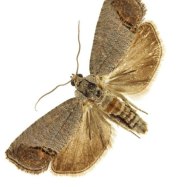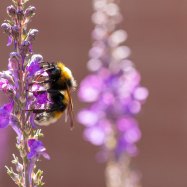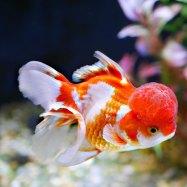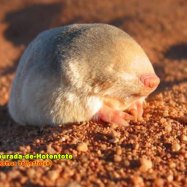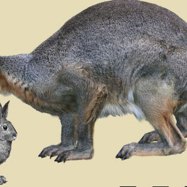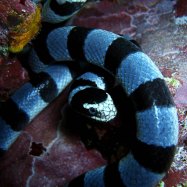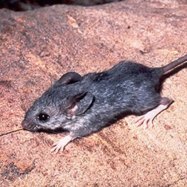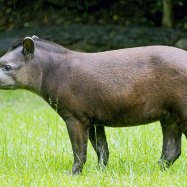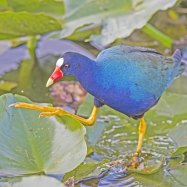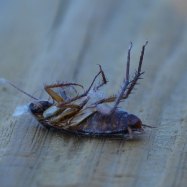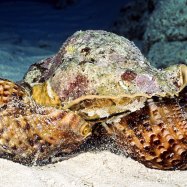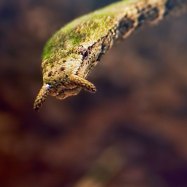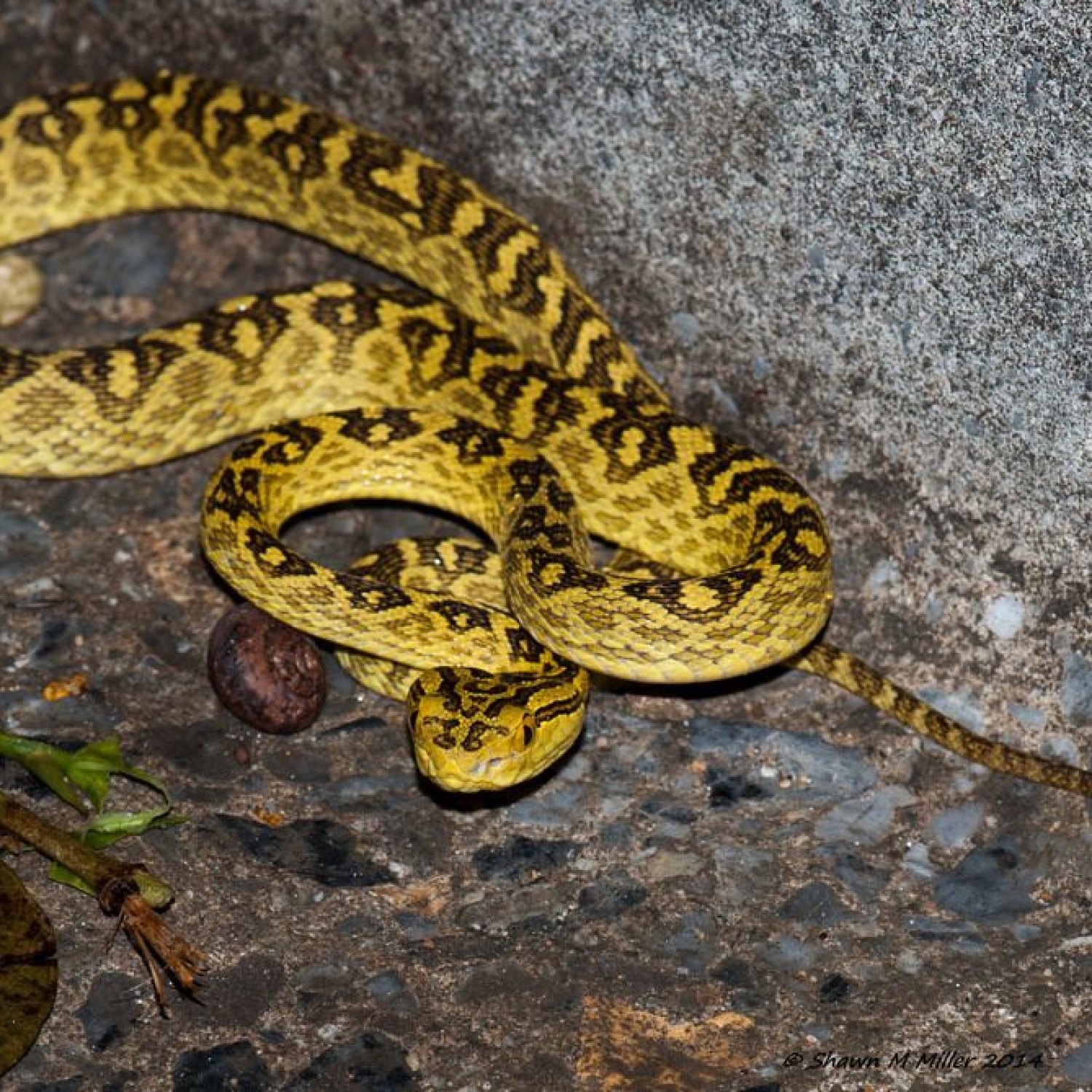
Habu Snake
Up to 2 meters (6.6 feet)
The Habu Snake, found in forests, grasslands, and wetlands, can grow up to 2 meters (6.6 feet) long. As a member of the Viperidae family, its body is thick and cylindrical. Known for its venomous bite, it is important to stay cautious when encountering the Habu Snake. #habusnake #viperidae #dangerousanimals
Animal Details Summary:
Common Name: Habu Snake
Kingdom: Animalia
Habitat: Terrestrial
The Deadly, Enigmatic Habu Snake: A Master of Adaptation
The world is full of dangerous animals, from fierce lions to deadly sharks. But there is one creature that often goes unnoticed, lurking in the shadows of East Asia, waiting for its next victim. It is the habu snake, also known as Trimeresurus flavoviridis, a venomous reptile with a fascinating history and a remarkable ability to adapt to its surroundings.The Basics of a Habu Snake
Let's start with the basics Habu Snake. The habu snake belongs to the Animalia kingdom and Chordata phylum, which includes all animals with a backbone. It belongs to the Reptilia class, which includes snakes, lizards, and turtles. Its order is Squamata, which includes reptiles with dry, scaly skin, and its family is Viperidae, which consists of venomous snakes.The habu snake is a terrestrial animal, meaning it lives on land, and it is a carnivore, meaning it feeds on other animals. Its geographical distribution is limited to East Asia, specifically Japan, Taiwan, and related small islands. Within these areas, the habu snake can be found in various habitats such as forests, grasslands, and wetlands. Its preferred habitat may vary depending on its location, but one thing remains constant – the habu snake is a master of camouflage.
The Elusive Nature of the Habu Snake
The habu snake's body is a work of art, with its yellow-green or brown coloration accented by dark markings. This unique coloration allows the snake to blend in seamlessly with its surroundings, making it almost invisible to its prey and predators alike Humboldt Penguin. When threatened, the habu snake can also change its color to a darker shade, making it even harder to spot.But the habu snake's ability to adapt doesn't stop at its color. Its body shape is thick and cylindrical, allowing it to move through tight spaces easily. This feature is handy when it comes to navigating through the dense vegetation of its natural habitat. This snake can also climb trees and swim, showing just how versatile it really is.
The Deadly Venom of the Habu Snake
Unfortunately, the habu snake's remarkable adaptability also extends to its venom, making it one of the most dangerous snakes in East Asia. Its venom is a potent mix of neurotoxins and hemotoxins, which can quickly paralyze its prey and cause internal bleeding, leading to a slow and painful death. Its venom can also be fatal to humans, making the habu snake a feared and revered creature in its natural habitat.But despite its deadly reputation, the habu snake only attacks humans when provoked or threatened. In most cases, it prefers to avoid humans altogether, making it a shy and elusive creature.
The Fascinating Behavior of the Habu Snake
One of the most intriguing aspects of the habu snake is its behavior. It is a solitary animal, only coming together with other snakes during mating season, which usually occurs in the spring. During this time, male habu snakes engage in combat to win the attention of the female. They intertwine their bodies, trying to push each other to the ground, and the first snake to lose balance loses the fight.Another interesting behavior of the habu snake is its hunting technique. Being a nocturnal animal, it hunts at night, using its excellent sense of smell to track down its prey. Once it has located its victim, it strikes with lightning-fast speed, injecting its venom into its prey. The snake then follows its prey, using its keen eyesight and heat-sensing pits to locate it.
Surprisingly, the habu snake is also known to hibernate during the colder months, typically between November and March. It will find a warm and sheltered spot, such as a burrow or a hollow tree, and stay there until the weather warms up again. This behavior allows the snake to conserve energy, making it an efficient survivor in its harsh environment.
The Habu Snake and Human Interactions
As mentioned earlier, the habu snake is not an aggressive animal towards humans. However, due to its venomous nature and potential danger to humans, there have been cases where it has caused harm. This has resulted in the snake being feared and even persecuted by humans, leading to its decline in some areas.In Japan, the habu snake is considered a pest and is often killed on sight. However, this has resulted in a reduction of its population, leading to an ecosystem imbalance and an increase in rodent populations. Some efforts have been made to educate the public about the importance of the habu snake in its natural habitat, and there are now laws protecting the species in Japan.
In Taiwan, the habu snake has a different reputation. It is considered a cultural symbol and is even featured on the Taiwanese dollar coin. The locals believe that the snake brings balance and harmony to the ecosystem and should be respected and protected.
The Habu Snake in Traditional Medicine
Apart from its cultural significance, the habu snake has also been used in traditional medicine for centuries. Its venom, specifically the hemotoxins, has been used to treat various ailments such as arthritis and high blood pressure. However, the use of the habu snake and its venom in traditional medicine has sparked controversy, with some arguing that it promotes the illegal capture of wild snakes, leading to a decline in their population.In recent years, there has been a shift towards more sustainable ways of using the habu snake in traditional medicine, such as breeding them in captivity. This ensures a steady supply of the snake's venom without causing harm to its natural population.
The Future of the Habu Snake
Despite its adaptability and cultural significance, the habu snake's future is uncertain. Like many other species, it faces threats such as habitat loss, pollution, and illegal poaching for traditional medicine or the exotic pet trade. But there is still hope for the habu snake, with ongoing conservation efforts and increasing public awareness about the importance of this elusive reptile.The Mystique of the Habu Snake
In conclusion, the habu snake is a remarkable creature, with a deadly reputation and a mysterious nature. Its ability to adapt to its surroundings and its unique coloration make it a true master of camouflage. Its behavior and cultural significance add to its mystique, making it a fascinating animal worthy of our attention and protection. Let us continue to appreciate and respect this enigmatic creature, and hopefully, we can ensure its survival for many years to come.

Habu Snake
Animal Details Habu Snake - Scientific Name: Trimeresurus flavoviridis
- Category: Animals H
- Scientific Name: Trimeresurus flavoviridis
- Common Name: Habu Snake
- Kingdom: Animalia
- Phylum: Chordata
- Class: Reptilia
- Order: Squamata
- Family: Viperidae
- Habitat: Terrestrial
- Feeding Method: Carnivorous
- Geographical Distribution: East Asia
- Country of Origin: Japan, Taiwan, and related small islands
- Location: Forests, grasslands, wetlands
- Animal Coloration: Yellow-green or brown with dark markings
- Body Shape: Thick and cylindrical
- Length: Up to 2 meters (6.6 feet)
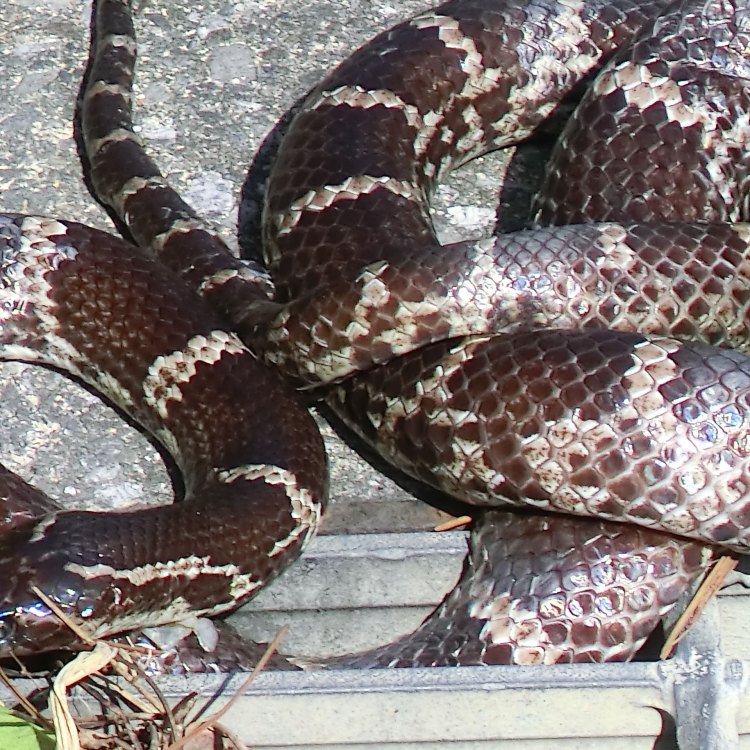
Habu Snake
- Adult Size: Large
- Average Lifespan: 15-20 years
- Reproduction: Ovoviviparous
- Reproductive Behavior: Mating occurs in spring
- Sound or Call: Hissing
- Migration Pattern: Non-migratory
- Social Groups: Solitary
- Behavior: Nocturnal and ambush predator
- Threats: Habitat loss, road traffic, hunting
- Conservation Status: Least Concern
- Impact on Ecosystem: Maintains balance within the ecosystem by controlling prey populations
- Human Use: Anti-venom production, traditional medicine
- Distinctive Features: Large, venomous fangs
- Interesting Facts: Habu snakes are responsible for the majority of snakebite incidents in Japan.
- Predator: Large birds of prey, mongoose, and humans
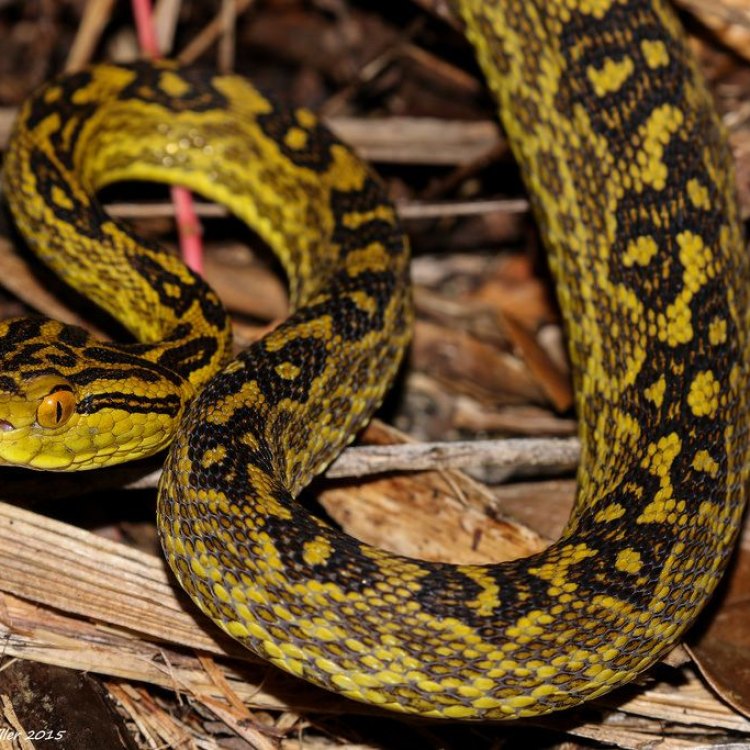
Trimeresurus flavoviridis
The Fascinating Habu Snake: An Enigmatic Creature in the Animal Kingdom
In the vast and mysterious world of snakes, there is one species that stands out for its unique characteristics and intriguing behavior - the Habu snake. This large and venomous snake is found in the subtropical regions of East Asia, primarily in Japan's Ryukyu Islands. Its scientific name, Trimeresurus flavoviridis, translates to "three-part-green," referring to its distinctive green-colored scales. But what makes this reptile truly stand out is not just its appearance, but its role in the ecosystem and its impact on humans PeaceOfAnimals.Com.Let's delve into the fascinating world of the Habu snake and learn more about its size, lifespan, behavior, threats, conservation status, and its distinctive features.
Size and Lifespan
The Habu snake is a formidable creature, with adults reaching an average length of 4-6 feet. In some rare cases, they can even grow up to 9 feet. This size makes them one of the largest venomous snakes in East Asia. The males are slightly larger than females, but both genders have similar coloration and markings.As with most snakes, Habu's grow throughout their lifetime, with their growth rate slowing down as they reach adulthood. They typically shed their skin 2-3 times a year, with each shedding resulting in a more vibrant and glossy appearance.
When it comes to their lifespan, Habu snakes can live up to 15-20 years in the wild. However, in captivity, they have been known to live much longer, with some documented cases of Habu snakes living up to 25 years Huskador.
Reproduction and Mating Behavior
One of the unique reproductive traits of the Habu snake is their mode of reproduction - ovoviviparous. Unlike most snakes that lay eggs, the Habu snake gives birth to live young ones. The female Habu carries her eggs in the lower part of her body until they are ready to hatch, which usually takes around 90 days.Mating in Habu snakes typically occurs in the spring season, with males competing for females through a ritualistic dance, where they intertwine and rub their bodies together. Once the female accepts the male, the mating process begins, lasting for a few hours.
After giving birth, the female Habu snake can have up to 20-30 offspring at once. The newborn snakes are independent and fully capable of taking care of themselves from the moment they are born.
Behavior and Predation
The Habu snake is a solitary and primarily nocturnal animal, preferring to hunt and roam at night. However, during the mating season, they become more active during the daytime. They are known to be ambush predators, patiently waiting for their prey to pass by before striking.Their diet primarily consists of small mammals like rodents, birds, lizards, and even other snakes. They have been observed to display an interesting hunting technique, where they use their powerful jaws to bite off a piece of their prey's flesh, then let go, allowing the victim to bleed out before feeding on it.
But like most animals, Habu snakes also have predators to worry about. Large birds of prey, such as the honey buzzard, red-footed booby, and the Chinese sparrowhawk, are known to hunt Habu snakes. They also have to compete with other predators, such as the mongoose, for food.
However, the most significant predator for Habu snakes is us humans. Habitat loss, road traffic, and hunting for their skin and meat have severely impacted their population and pushed them towards the brink of endangerment.
Threats and Conservation Status
The Habu snake is listed as "Least Concern" on the IUCN Red List of Threatened Species, thanks to its large population and wide distribution. However, various human activities have been detrimental to their survival.Habitat loss due to the rapid development of human settlements has resulted in a decline in suitable habitats for Habu snakes. These developments also bring human-snake conflicts, leading to the snakes being killed out of fear or for their valuable skin.
Road traffic is another significant threat to Habu snakes. As they are primarily nocturnal animals, they often come out to hunt at night, making them vulnerable to being run over by vehicles on the road.
Lastly, illegal hunting for their skin and meat has caused a decline in their population, even leading to local extinctions in some areas. However, thanks to conservation efforts and strict laws against hunting and trading, the Habu snake population is gradually stabilizing.
Impact on the Ecosystem
Aside from being an essential part of East Asian culture, the Habu snake plays a vital role in maintaining the balance within the ecosystem. As an apex predator, they control the population of their prey, thus preventing overpopulation of smaller animals. This, in turn, helps maintain the health of the ecosystem.By keeping the population of small mammals, birds, and other snakes in check, Habu snakes play a significant role in maintaining a healthy ecosystem. They also help control the spread of diseases among small animals, ultimately benefiting the entire ecosystem.
Human Use and Interesting Facts
The Habu snake has been a part of East Asian culture and tradition for centuries. Its venom has been used in anti-venom production and traditional medicine. In Japan, Habu snake wine is also a popular beverage believed to have medicinal properties.However, one of the most interesting facts about Habu snakes is that they are responsible for the majority of snakebite incidents in Japan. Due to their aggressive nature and potent venom, they are often involved in snakebite accidents, resulting in around 3000 snakebites annually.
In addition to humans, other animals have also been known to use the Habu snake for survival. The mongoose, a natural predator of Habu snakes, has developed a unique resistance to their venom by developing special enzymes in their liver that neutralize Habu venom.
Distinctive Features
One of the most prominent features of the Habu snake is its large venomous fangs. These fangs, located in the front of their mouth, are used to inject their venom into their prey. The venom of the Habu snake is neurotoxic, affecting the nervous system and causing paralysis in its victims.Apart from their fangs, Habu snakes have a distinctive triangular-shaped head, with a thick body covered in glossy green scales. These scales not only provide protection but also help retain moisture, allowing them to live in dry environments.
In Conclusion
The Habu snake is an enigmatic creature in the animal kingdom, with its unique characteristics, behavior, and role in the ecosystem. From their size and lifespan to their reproductive behavior and impact on humans, this reptile is truly fascinating.While they may evoke fear in some, Habu snakes are an essential part of the ecosystem and deserve to be protected. With proper conservation efforts and more awareness about their importance, we can ensure the survival of these magnificent creatures for generations to come.
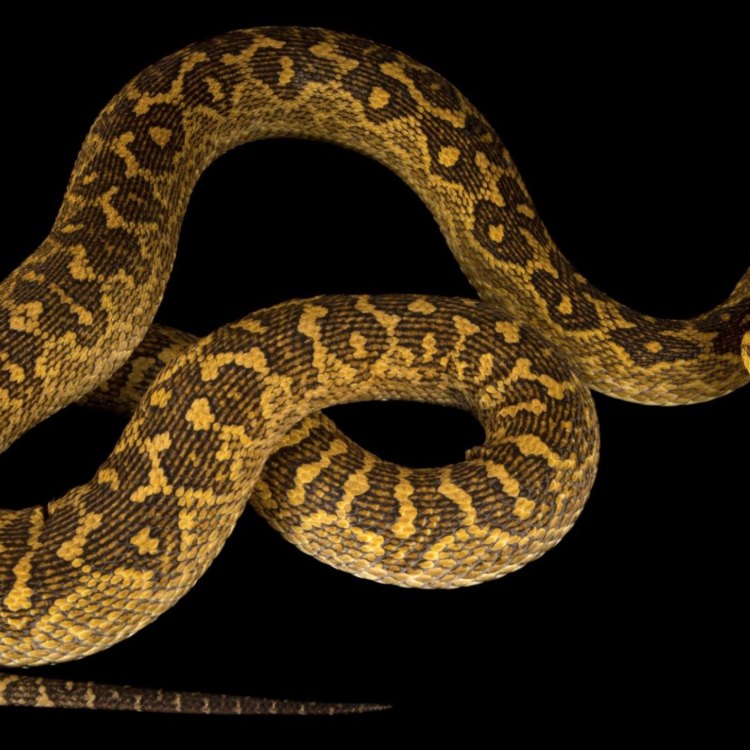
The Deadly, Enigmatic Habu Snake: A Master of Adaptation
Disclaimer: The content provided is for informational purposes only. We cannot guarantee the accuracy of the information on this page 100%. All information provided here may change without prior notice.

